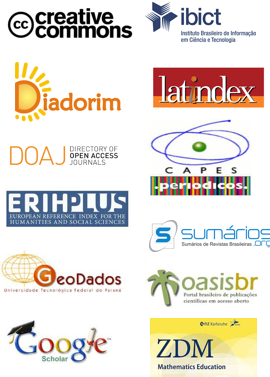A Resolução de Problemas Sobre Perímetro e Área: um Experimento de Ensino, Utilizando Problemas Propostos em Avaliações de Larga Escala
DOI:
https://doi.org/10.17921/2176-5634.2024v17n2p150-158Resumo
Este artigo apresenta um recorte dos dados da pesquisa de doutorado do primeiro autor, cujo objetivo foi investigar se o ensino pautado nos pressupostos da metodologia de Ensino-Aprendizagem-Avaliação de Matemática por meio da Resolução de Problemas favorece a construção, aprofundamento e ampliação da aprendizagem dos conceitos de perímetro e área. Para tanto, foi proposto a um grupo de estudantes da 3ª série do Ensino Médio, de uma escola pública do estado de São Paulo, a resolução de dois problemas, com características dos apresentados em avaliações de larga escala. Para analisar as respostas dos estudantes, apoia-se na perspectiva da mudança e jogo de quadros de Douady. Os resultados mostraram que os estudantes apresentaram diferentes heurísticas, ligadas a diferentes quadros – geométrico, numérico e algébrico – para resolverem o mesmo problema. As heurísticas apresentadas nas soluções evidenciaram que o contexto do problema não causou dificuldades de interpretação e não interferiu na mobilização de estratégias, ao contrário da natureza dos problemas. Este fato interferiu diretamente no trabalho com a mudança de quadros. Considerando que a natureza dos problemas da intervenção contemplou a interrelação de conceitos que poderiam pertencer a habilidades de quadros distintos, inferimos que os resultados denotaram certa insegurança dos estudantes para se lançarem à resolução de um problema quando era necessária ou adequada a mudança de quadro. Todavia, os estudantes desenvolveram a atitude de valorizar o trabalho coletivo, colaborando na interpretação de situações-problema, na elaboração de estratégias de resolução e na sua validação.
Palavras-chave: Ensino Médio. Resolução de Problemas. Heurística. Mudanças de Quadros.
Abstract
In this work we present an excerpt from Santos' doctoral research, the objective of which was to This article presents a sample of data from the first author's doctoral research, whose objective was to investigate whether teaching based on the assumptions of the Mathematics Teaching-Learning-Assessment methodology through Problem Solving favors the construction, deepening and expansion of learning the concepts of perimeter and area. To this end, a group of 3rd year high school students from a public school in the state of São Paulo were asked to solve two problems, with characteristics of those presented in large-scale assessments. To analyze the students' responses, we sought support from Douady's perspective of change and frame play. The results showed that students presented different heuristics, linked to different tables, to solve the same problem. The heuristics presented in the solutions showed that the context of the problem did not cause difficulties in interpretation and did not interfere in the mobilization of strategies, contrary to the nature of the problems. This fact directly interfered in the work with the change of staff. Considering that the nature of the intervention problems included the interrelationship of concepts that could belong to skills from different frameworks, we infer that the results denoted a certain insecurity on the part of the students to undertake the resolution of a problem when a change of framework was necessary or appropriate. However, students developed the attitude of valuing collective work, collaborating in the interpretation of problem situations, in the development of resolution strategies and in their validation.
Keywords: High School. Problem Solving. Heuristic. Frame Changes.


